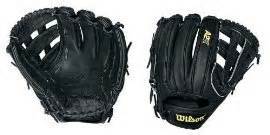Choosing Outfield Gloves:
Outfield gloves vs. infield gloves, is there a difference and what is the difference if there is? Many people may be surprised by the above statement, not really ever stopping to consider there may be differences, there are and they are substantial.
That’s why it’s important to know what you’re looking for in a glove before shelling out up to $500, or more, for a good leather hide mitt, which you may not be pleased with or which doesn’t address the needs of the player.

When shopping for a glove, especially in younger players, it’s important they accompany you in order to try the glove on and insure it properly fits their hand, because trying to use a glove too big, because it looks cool or because of an autograph, is an invitation to a disaster occurring in the field.
Before I go any further I want to say this, when dealing with younger players, who neither themselves nor their coach actually know what position they will eventually settle into, it’s best to choose the smaller glove and you’ll understand what I mean in a minute.
Which Job?
Not unlike most other tools, and that’s exactly what a glove is to a ball player, they are designed to help accomplish a specific job. You don’t use a hammer to put screws into the wall, nor do you use a screw driver to hammer nails, as the tools have specific purposes.

H Webbing
Simply defined, an infielder’s glove must be smaller, because the fast pace of infield play requires a player to be able to quickly retrieve the ball from the glove and throw. Infielders do not have the time luxury of fishing around inside a huge web in order to locate and properly grasp the ball for throwing.
Whereas, an outfielders’ glove should be as large as practical in order to offer the fielder every inch of coverage they can muster while chasing tailing line drive or leaping to bring, what should have been a home run ball, back into the ball park.
This is why I recommend buying the smaller infield glove for young players, as for the most part they will not be negatively affected by using the smaller glove if playing outfield, but using an outfield glove on the infield is really difficult and unfair to the player trying to lug the monster around.
In order to determine the different gloves if unmarked, an outfield glove is usually 12.75“ inches long, although some models range from 12.5” to 13” long.
This could explain why, while trying on gloves from the same shelf or rack, there suddenly seems to be a difference in how the gloves feel on the hand. So always buy the glove you’ve had on your hand and like the feel of, not the one next to it or the black glove instead of the leather color, because there may be more different than just the color.
Once we’re sure we have picked the right glove for the job and the fit is correct, check to make sure the glove is large enough to be able to develop a long, deep pocket capable of snagging rapidly moving fly balls and line drives.
This is where the web design becomes very important, and although a personal preference, there are factors to consider. For an outfielder, because he rarely has another close team mate unless the ball is hit in the center field gaps, he can’t count on anyone helping him track a fly ball hit into the sun’s glare of a high sky, or the blinding brightness of stadium lighting.
He must be able to use his glove as a shield in order to block just enough glare, which allows him to see and catch the ball, and this is where the web design becomes crucial.

Outfield gloves have Webbings which come in two basic styles, although some will be slightly varied for looks or for a Trademark or patent issue.
The Trapeze or Flytrap web have proven their value for their flexibility, which offers a great amount of confidence the glove will snap shut upon impact, catching and firmly holding the ball no matter how hard you are running.
The Dual Post or H Web offers extra strength and sturdiness which insures reliability no matter how hard the ball is hit, and in my opinion this type of web offers the user a better option of using various positions to see through the web while shielding the eyes from the sun or lights.
Outfield Gloves, as well as other equipment, have become so technologically driven that buying a glove today is as frustrating and complicated as buying a luxury automobile. You can load it up with expensive options, but only you know if they are worth the costs.
Luxury items like a cushioned closed back, Deguchi leather or cushioned wrist pads are but a few of the available options, and unless I was expecting to be a high draft choice or offered a college scholarship, I wouldn’t spend the extra money, but that’s just me.
If you plan on buying your glove off the internet, take special care to compare the exact specifications of the net glove to be sure it is identical to the one tried on in the store, and this especially concerns the glove manufacturer brand. A Rawlings will not be exactly the same as a Wilson.
Outfield Gloves to Outfield Play
Learn Youth Baseball Coaching

New! Comments
Have your say about what you just read! Leave me a comment in the box below.